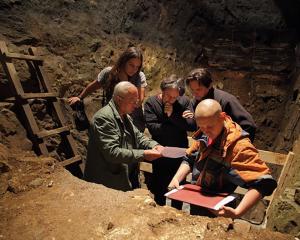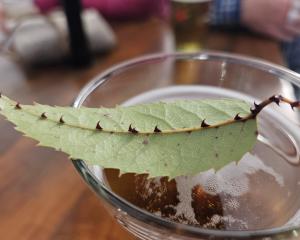Having been the scene in 1792 and 1793 of New Zealand's first permanent settlement, sealing expedition, ship construction, recorded earthquake and lost cat, Dusky Sound might appear to have made more history than could be consumed locally.
However, the still-remote sound was, shortly after those historic events, once again to be the scene of another famous first.
This was the first shipwreck or abandonment of a ship in New Zealand recorded history.
For many years, the skeletal remains of a ship lying in Facile Harbour in Dusky Sound were believed to be those of Madagascar, a vessel bound for the UK from Melbourne in the early days of the Victorian gold rush and carrying a cargo of gold.
After leaving Melbourne, it was never heard of again.
It was widely believed the crew of Madagascar took over the ship and ran it into Dusky Sound.
They are then alleged to have buried boxes of gold in Dusky Sound, marking the spot with a pickaxe dug into a tree.
As in almost all such stories, the crew was alleged to have fought among themselves until only three remained.
They are said to have made their way over to the Wakatipu region where local Maori found them in a debilitated state.
There the story ends.
No-one ever found the pickaxe, or the gold, and the wreckage in Dusky Sound is not that of Madagascar or of James Cook's old Endeavour, as has also been suggested.
However, it is easy to see how this latter story arose, because the wreckage (some of which still remains) was that of another Endeavour and one that has a place in New Zealand's history not quite as illustrious as Captain Cook's.
However, the very remarkable story of the events surrounding the wreckage of the Endeavour in Facile Harbour was not clarified until 1906.
In that year, the great recorder of southern history, Robert McNab, found the log of Captain Robert Murry at the Essex Institute in Salem, Massachusetts.
McNab, a man of scholarship, wealth and leisure had been researching the operations of the Nantucket whalers in southern New Zealand in the early 19th century when he unexpectedly came on Murry's log.
This document reveals not only what the wreckage in Facile Harbour is, and how it came to be there, but also a quite astonishing episode in the early history of New Zealand.
Robert Murry had been the fourth officer of Britannia under the redoubtable Captain Raven, which had visited Dusky Sound in 1792 and 1793.
He had left a sealing gang (New Zealand's first) who built a vessel against his failing to return for them.
When Capt Raven returned for them, this almost completed ship was left on the stocks.
McNab read that Capt Murry was still fourth mate of Britannia with Capt Raven in May 1795, anchored in Sydney.
Enderby and Co, a franchisee of the great East India Company, which had been awarded sole trading rights to the southern seas by the UK Parliament, owned Capt Raven's vessel.
At anchor alongside Britannia was another vessel engaged in the same trade.
This was an East Indiaman, Endeavour of 800 tons, and out of Bombay.
Endeavour was old and leaky.
William Bampton, who had informed this condition to the New South Wales authorities as an explanation for his late arrival at Sydney with a cargo of livestock from Bombay, captained it.
Capt Murry's log recounts how Capt Raven suddenly advised him that he stood a better chance of promotion from fourth mate by taking up a similar position in Endeavour with Capt Bampton.
After hiring some carpenters and a competent shipwright, Capt Brampton promptly set sail for (you've guessed it) Dusky Sound.
Obviously, Capt Raven had told Capt Bampton of a recently built vessel which, although much smaller than Endeavour, appeared to be sound and which was there for the taking.
Whatever passed between the two captains is not known, but it seems strange even at this distance in time, that a captain should dispense with a very experienced officer without some significant inducement.
There is no clarification of this, or of the apocryphal story that Endeavour was a new name for the vessel after it had been refused insurance by Lloyds of London under its previous name because it was in such poor condition.
Whatever the truth of the matter, it has all the hallmarks of a cunning plan worthy of Baldrick.
On September 18, 1795, Endeavour left Sydney for Dusky Sound, accompanied by the 150-ton brig Fancy commanded by one Capt Dell.
The voyage began a la Blackadder too.
Capt Murry recounts that scarcely had they cleared Sydney when the captain discovered Endeavour had shipped 41 stowaways, including one woman.
The ingenuous Capt Murry expressed surprise at this and suggested in his log that it was all very suspicious.
The voyage was a nightmare, and on reaching Dusky Sound, Capts Bampton and Dell both agreed the little vessel still on the stocks there was in much better state than Endeavour.
All hands turned to building huts to accommodate the crews of Endeavour and Fancy, as well as the stowaways from Sydney and the passengers to Bombay that Endeavour had been carrying.
The huts were needed because the existing house built by the 1792 sealing party could never have held the 244 people who were now ashore, albeit unwillingly, in Dusky Sound.
Next, almost everyone turned to stripping Endeavour of everything of value and this was accomplished, except for the loss of two cannons.
These lay in Facile Harbour until 1984, when they were recovered by Kelly Tarlton.
Meanwhile, the carpenters were finishing off and caulking the little vessel left by the sealers.
She was finally declared seaworthy and launched as Providence, displacing about 70 tons and rigged as a schooner.
So the first vessel in Australia and New Zealand constructed from local timber (rimu) was finally launched.
Endeavour came to a sad end.
She either broke from her moorings or (more likely) was unmoored on October 25, 1795, during a violent storm.
Two days later, she struck a rock and sank.
Some of the wreckage lies there today and was the foundation of the myths about the lost Madagascar and about the wreckage being that of Capt Cook's Endeavour.
On shore, all was not well.
The stowaways initially refused to do any work until Capt Bampton threatened to cut their rations.
The officers and the passengers from Endeavour were also quarrelsome.
Capt Murry records an altercation between Mr Alms, a passenger who was a crack pistol shot, and Mr Waine, the first officer of Endeavour.
It could have come straight from the records of the illustrious Pickwick Club or from the anteroom of the Drones Club, beloved of Bertie Wooster.
However, despite all the problems, preparations went ahead for leaving Dusky Sound.
The main problem was that while the wrecked Endeavour displaced 800 tons, the newly completed Providence displaced 70 tons.
Capt Bampton had a plan.
First of all, he removed Capt Dell from the little Fancy and took command of that vessel himself, placing Capt Dell in command of Providence.
However, there was not enough room in these two vessels for the 244 people at Dusky Sound.
Fancy would carry 64 people and Providence just 90.
This left another 90 people without a ship.
Capt Bampton was not dismayed.
He commanded that Endeavour's longboat be stripped to the framework and reclad in the local rimu.
He also ordered the refurbished longboat to be rigged for sail.
However, time was running on and, in early January 1795, Fancy and Providence fully loaded, sailed for Bombay, via the penal colony of Norfolk Island.
Before leaving, Capt Bampton left the hapless First Officer Waine in charge of the refurbished longboat, and ordered him to sail for Sydney when it was completed.
Two weeks later, Fancy and Providence arrived off Norfolk Island, where Capt Bampton sought fresh food and water and offloaded 32 of the escaped convicts.
The two vessels then sailed off to Bombay where Capt Bampton would land his passengers and seek further trade.
The Dusky-built Providence was placed under the command of Capt Murry.
In his log, he recounts how the vessel was not a good sea boat and that Capt Bampton in Fancy finally left the slower vessel to its own fate.
Luckily, Providence was able to reach Batavia, today's Jakarta, in what was then the Dutch East Indies.
Capt Murry and the rest of his shipmates were repatriated but the first sea-going vessel built in either Australia or New Zealand never left Jakarta.
Meanwhile, back at Dusky Sound, the converted longboat was ready for sea and had been named Assistance by FO Waine.
She had a displacement of only about 60 tons and space was once again the problem.
Assistance could carry only 55 people to Sydney.
FO Waine left 35 behind with some of the rations and sailed off to Sydney, which was reached on March 17, 1795, without losing one of the passengers or crew.
It was a remarkable feat of construction and seamanship.
According to a nautical report compiled in Sydney, Assistance was built entirely of timber from Dusky Sound and appeared of miserable condition.
Nevertheless and despite this disparaging remark, this little vessel not only carried 55 people across the stormy Tasman to safety but also has the distinction of being the second sea-going vessel built in Australian and New Zealand.
She was subsequently sold in Sydney, and the proceeds went to Capt Bampton.
The 35 people left at Dusky Sound remained there and suffered great privation until an American whaler sent by the government of New South Wales took them off in June 1797.
So ended an astonishing incident in this country's early history.
It highlights the resourcefulness and courage of the men who sailed the southern seas in the 18th and 19th centuries and who provided a colourful entree to New Zealand's European settlement in the mid-19th century.











